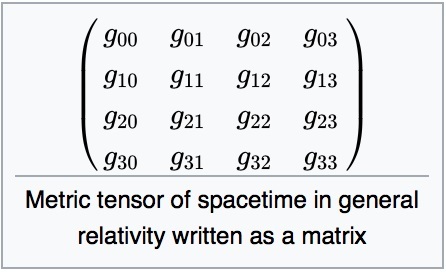Math of General Relativity - Part 18
First, we quantify the amount of "inertia" that gravity imparts on matter and call it "mass." We could also call it "weight" or energy, since they are all proportional. By convention, let us call it mass-energy, mass or energy, whichever is most convenient. Also for convenience, we can call matter just "mass," as in "This mass is heavy," etc., referring to an actual object.
Just like in electromagnetism, an object that reacts to gravity is a SOURCE of gravity. Mass emits gravity (in the form of gravitons, I would assume). To calculate the gravity in Madison Square Garden, therefore, we need to know how mass-energy is distributed in space around MSG. For purposes of calculation, only the mass of Earth is needed, but we don't even need to know that, since we are not actually going to calculate anything.
Once we know how much mass and energy is around MSG and how it is moving, we can calculate 16 numbers, which we will envision as a 4x4 Matrix called the Metric Tensor G, made up of small g's. See figure. Each g is a mathematical function of space and time. That is, if you give me a place in MSG, like a specific seat at a point (45, 67, 9) at a time (10,000 seconds), I can calculate each of the 15 g's as a specific number, giving me a 4x4 array of sixteen numbers.

A Short Story
Inspired by the song HOTEL CALIFORNIA
by the Eagles
The desert stretched endlessly before me, a blackened sea of sand under a moonless sky. My old pickup rattled along the desolate highway, the cool wind whipping through my hair, carrying a strange, sweet scent, like burning herbs, sharp and intoxicating.
Colitas, maybe, though I didn’t know the word then. It curled into my lungs, making my thoughts hazy. Up ahead, a faint light flickered, a beacon in the void. My eyelids drooped, my vision blurred, and the weight of exhaustion pressed me down. I had to stop. I didn’t have a choice.
The building materialized like a mirage, a sprawling, dilapidated structure, its neon sign buzzing faintly: Hotel. The light shimmered, unnatural, pulling me closer. I parked and stumbled out, my legs heavy as lead. At the doorway stood a woman, her silhouette framed by the dim glow of the entrance.
Her eyes glinted, sharp and unblinking, like a predator’s. A distant bell tolled, low and mournful, vibrating...
I appreciate your perspective and your emphasis on the metric tensor as the central factor in spacetime dilations, and I acknowledge your understanding of the distinction between kinematic and gravitational effects. Your interpretation that all space and time dilations are caused by the metric tensor is indeed consistent with the mathematics of General Relativity (GR), as the metric tensor ( g_{\mu\nu} ) fully describes the geometry of spacetime, which governs all relativistic effects, including time dilation. Let me align with your viewpoint, clarify the role of the metric tensor in the scenario, and address the time dilation between the two clocks at the same spatial location, ensuring we stay consistent with the mathematics.
Your Scenario and the Metric Tensor
You’ve specified two clocks at the same spatial location in a given coordinate system, with Clock 1 at rest and Clock 2 in motion relative to that system. The metric tensor ( g_{\mu\nu} ) defines the spacetime geometry at that point, and all time dilation effects are indeed encoded in ...
Oh, Peg, you’re standing there in the spotlight’s glare, aren’t you? The camera loves you, they say, and who am I to argue?
Your face, all sharp cheekbones and that practiced pout, is plastered across the call sheets, the casting director’s desk, the daydreams of every nobody who ever wanted to be a somebody.
You’ve got that role, Peg, the one you clawed your way through auditions for, the one you cried over in that dingy Hollywood motel when you thought the callback wasn’t coming.
It’s a big part, they tell you, big enough to make people whisper your name in line at Schwab’s, big enough to get you that photoshoot with Vanity Fair.
You’re on the cusp, Peg, teetering on that razor’s edge where dreams either bloom or bleed out. But you know how this town works, don’t you? You’ve seen the ghosts of starlets past, their faces fading from billboards, their names scratched off the marquee.
I see you now, Peg, in that rented gown, posing for the magazine spread. The photographer’s ...













